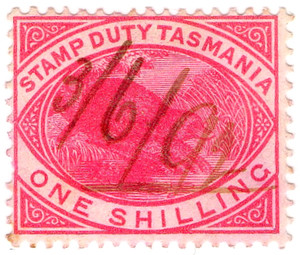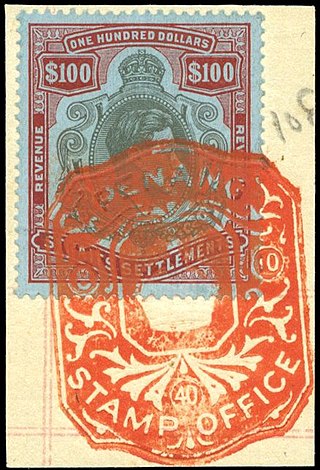
An overprint is an additional layer of text or graphics added to the face of a postage or revenue stamp, postal stationery, banknote or ticket after it has been printed. Post offices most often use overprints for internal administrative purposes such as accounting but they are also employed in public mail. Well-recognized varieties include commemorative overprints which are produced for their public appeal and command significant interest in the field of philately.

Indian postal systems for efficient military and governmental communications had developed long before the arrival of Europeans. When the Portuguese, Dutch, French, Danish and British conquered the Marathas who had already defeated the Mughals, their postal systems existed alongside those of many somewhat independent states. The British East India Company gradually annexed the other powers on the sub-continent and brought into existence a British administrative system over most of modern-day India, with a need to establish and maintain both official and commercial mail systems.

The postal history of Portuguese India goes back to the earlier days of the colony. The postal history begins with communication between the Viceroy and the Court at Lisbon soon after the conquest of Old Goa by Afonso de Albuquerque in 1510. Letters, written in triplicate, were carried by separate ships because of the hazards of the voyage. Mail was carried by an overland route, as well. The early communications of Portuguese India had an official character and the correspondence is now to be found in museums and governmental and ecclesiastical archives.

The history of the postage stamps and postal history of China is complicated by the gradual decay of Imperial China and the years of civil war and Japanese occupation in the 1930s and 1940s. In modern times, postal delivery is handled by China Post.
This is a survey of the postage stamps and postal history of Macau.

Postage stamps and postal history of the Canal Zone is a subject that covers the postal system, postage stamps used and mail sent to and from the Panama Canal Zone from 1904 up until October 1978, after the United States relinquished its authority of the Zone in compliance with the treaty it reached with Panama.

Argentine postage stamps were first issued in 1858 by the Argentine Confederation and nationally by the new Republic's National Postal Service in 1862. Due to the continuing civil wars, a number of provinces and territories, particularly in the then-remote far north and far south, continued to issue their own postage brands and stamps for some time, afterwards; some of these issues have since become collectors' items.

The postal history of Malta began in the early modern period, when pre-adhesive mail was delivered to foreign destinations by privately owned ships for a fee. The earliest known letter from Malta, sent during the rule of the Order of St John, is dated 1532. The first formal postal service on the islands was established by the Order in 1708, with the post office being located at the Casa del Commun Tesoro in Valletta. The first postal markings on mail appeared later on in the 18th century.

Postage stamps of Pakistan are those issued since Pakistan's independence in 1947. Pakistan Post has issued more than 600 sets and singles totalling more than 1300 stamps. Immediately after the independence of Pakistan in 1947, the new Pakistan government was preoccupied with setting up the government so British Indian stamps continued in use without an overprint as was the practice in other countries.

Local postal surcharge labels are a class of labels applied widely to Chinese internal mail between January 1987 and February 1999. They have also been called Additional Charge Labels and Added Charge Labels.

The first postage stamps of Bhutan were issued in 1962, the same year that the first motorable road was opened. Before that there was a mail delivery system in place for official mail using mail runners, and between 1955 and 1962 revenue stamps were accepted as payment for internal mail. With the opening up of Bhutan in the early 1960s, a formal postal system was introduced.
This is a survey of the postage stamps and postal history of Sri Lanka, formerly known as Ceylon.

This is a survey of the postage stamps and postal history of Uruguay.

This is a survey of the postage stamps and postal history of Sierra Leone.

The Republic of South Sudan became independent on 9 July 2011 from Sudan and issued its first stamps on 13 July 2011. Only almost three months later, on 4 October 2011, did South Sudan become a member of the Universal Postal Union (UPU). Before independence, South Sudan used stamps issued by Sudan. The Directorate of Postal Services of the Ministry of Telecommunication and Postal Services is responsible for postal affairs in South Sudan.

The Australian state of Tasmania issued adhesive revenue stamps from 1863 to 1998, although impressed stamps had appeared briefly in the 1820s. There were general revenue and stamp duty issues, as well as a number of specific issues for various taxes.

The island of Cyprus first issued revenue stamps in 1878 and continues to do so to this day. The Turkish Republic of Northern Cyprus also issues its own revenue stamps.

Rhodesia, now divided between Zambia and Zimbabwe, first issued revenue stamps in 1890, and Zimbabwe continues to do so to this day.

Hong Kong issued revenue stamps from 1867 to the 1990s, both when it was a British colony as well as when it was under Japanese occupation.

Malaysia first issued revenue stamps as the Straits Settlements in 1863, and continues to do so to this day. Over the years, a number of entities in modern Malaysia have issued revenue stamps.


















